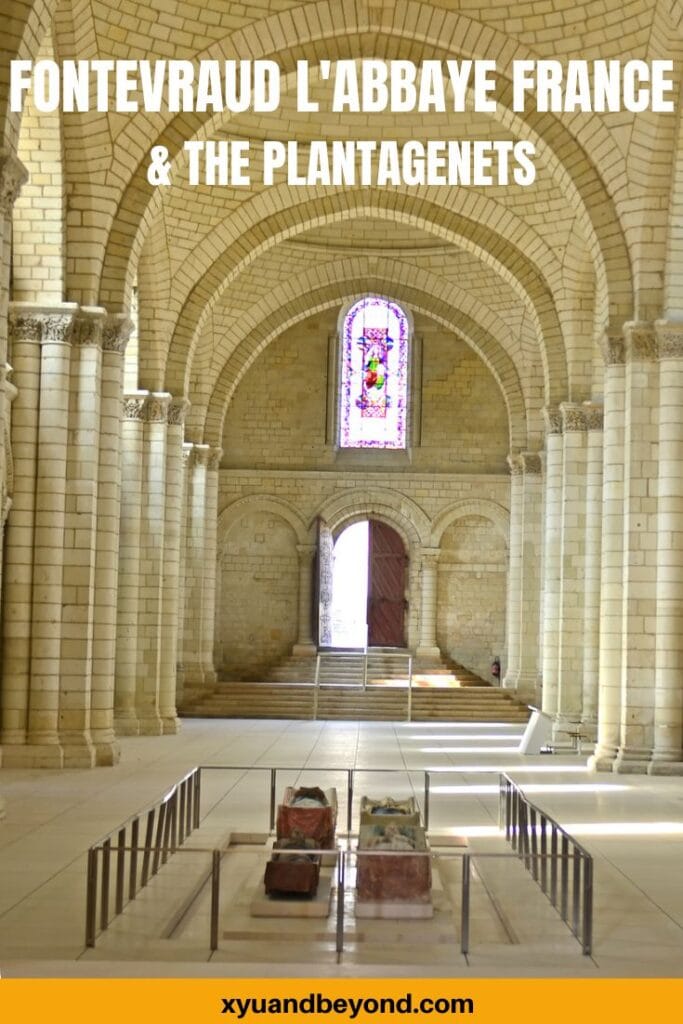Fontevraud Abbey: Home of powerful women of France
Every medieval history buff will know of the Fontevault Abbaye Anjou France, a UNESCO World Heritage Site between Chalonnes-sur-Loire and Sully-sur-Loire, and is within the Loire-Anjou-Touraine French regional natural park.
Where is Fontevraud Abbey? Fontevraud Royal Abbey is perched on the banks of the Loire and is close to the medieval city of Saumur. This is the place to be if you are obsessed with visiting some of the most beautiful chateaux and castles in France.

Who is buried at Fontevraud Abbey? Fontevraud Abbey is the original resting place of King Henry II of England, his wife Eleanor of Aquitaine, their son King Richard I of England, their daughter Joan, their grandson Raymond VII of Toulouse, and Isabella of Angoulême, wife of Henry and Eleanor’s son King John.
Queen Victoria once asked the abbess to send the remains of her ancestors Henri, Richard and Eleanor to England for re-burial. The abbess refused graciously, explaining that they were, after all, French.
- Fontevraud Abbey: Home of powerful women of France
- How to get to Fontevraud L’Abbaye
- Fontevraud Village
- Fontevraud Abbey History
- Women of Fontevraud Abbey
- Fontevraud Abbey Eleanor of Aquitaine
- What is the difference between a Monastery and an Abbey
- Burial place of Richard the Lionheart
- The French Revolution and Fontevraud
- Fontevraud Prison
- What to see at Fontevraud L'Abbaye
- Eglise Saint-Michel à Fontevraud-l'Abbaye
- Where to Stay When Visiting the Abbey of Fontevraud
- Where to eat at Fontevraud
Xyuandbeyond is reader-supported. When you buy through links on our site, we may earn an affiliate commission. You can read my privacy policy here.
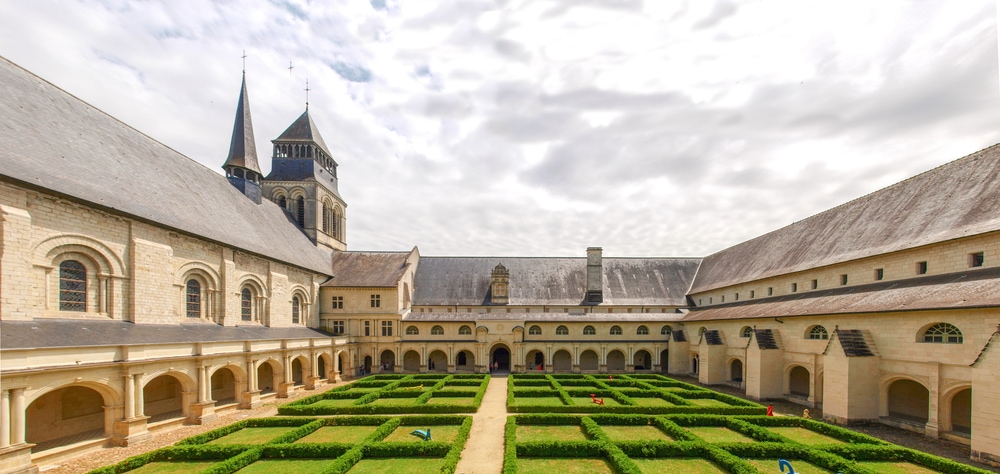
How to get to Fontevraud L’Abbaye
Fontevraud Abbey is not easy to get to from Paris unless you rent a car and the drive will be around 3 hours. If you are visiting Tours, which is the capital of the Indre-et-Loire department of France, set on the Loire River. This is the major tourist centre for the Loire valley and its historic châteaus. Again you will have to rent a car to get to the Abbey.
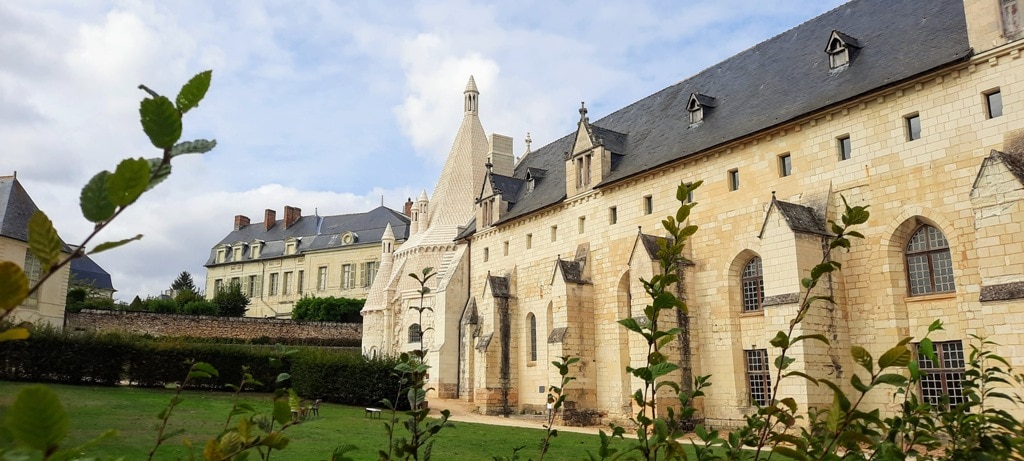
When driving you will pass hundreds of acres of vineyards, lavender fields, sunflower fields and small pretty villages on your way to Fontevraud it is a very easy drive. Don’t forget to visit Saumur and wander the old town where you can enjoy some of the famous Saumur wine with a delicious traditional Anjou meal.
Fontevraud Village
In the village of Fontevraud Abbaye, Anjou France, you’ll find what is the largest collection of monastic buildings in all of France and surrounding the Abbaye are a selection of small shops, restaurants, cafes and a tourist office.
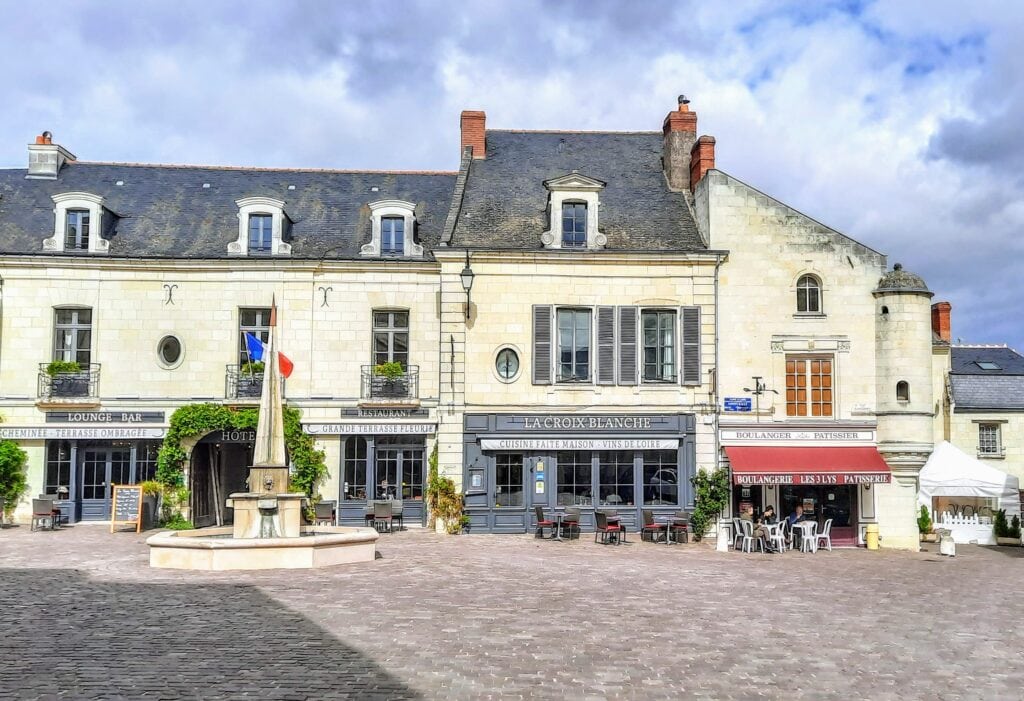
There is parking although I must admit it does feel a little strange to drive around the cobbled village square. On the square which is called the Place des Plantagenets, you will find the Hotel la Croix Blanche a gorgeous luxury hotel with a great restaurant and Chez Mimie a bed and breakfast.
There is also a boulangerie on the corner of the Place des Plantagenets which serves the best coffee and pastries. Sadly we were there in late September so many of the shops are seasonal and were closed but it is a pretty place to wander.
Fontevraud Abbey History
Fontevraud Abbey was founded by a reformed preacher Robert of Arbrissel, who had just created a new order, the Order of Fontevraud. The Order of Fontevraud was composed of men and women which was distinctly unusual during the middle ages. The Rule of the Order was based on the Rule of Saint Benedict: Ora et labora (prayer and work), poverty, chastity, obedience, and silence. Robert of Arbrissel entrusted the leadership of the Abbey and the Order to a woman, the abbess.
This mixed-gender monastery was light years ahead of its time and its leadership by women caused a lot of controversy in its day but Fontevraud Abbey went on to greatness with 36 Abbesses each managing the Order of Fontevraud and enhancing its reputation across Europe.
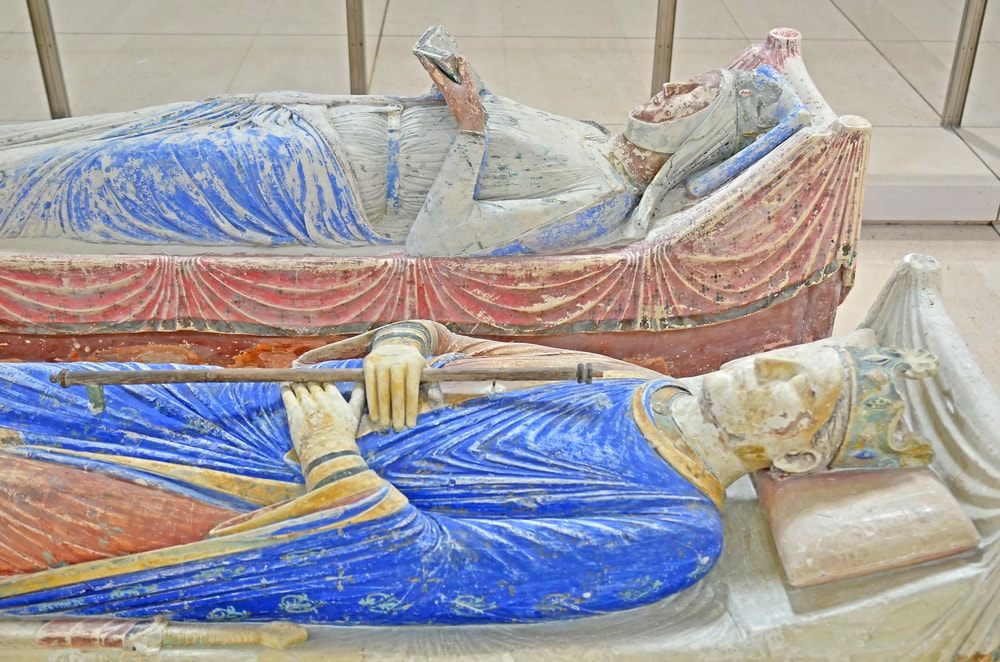
Women of Fontevraud Abbey
It was Philippa of Toulouse who persuaded her husband William IX, Duke of Aquitaine to grant Abrissel land to establish a religious community dedicated to the Virgin Mary. Fontevraud abbey was founded in 1100 and became a double monastery, with both monks and nuns on the same site.
Arbrissel declared that the leader of the order should always be a woman and appointed Petronille de Chemilléas the first abbess. She was succeeded by Matilda of Anjou, the aunt of Henry II of England. These women made Fontevraud Abbey the refuge for abused women, and prostitutes seeking a way out of their life. It also housed a leper hospital and an old age home.
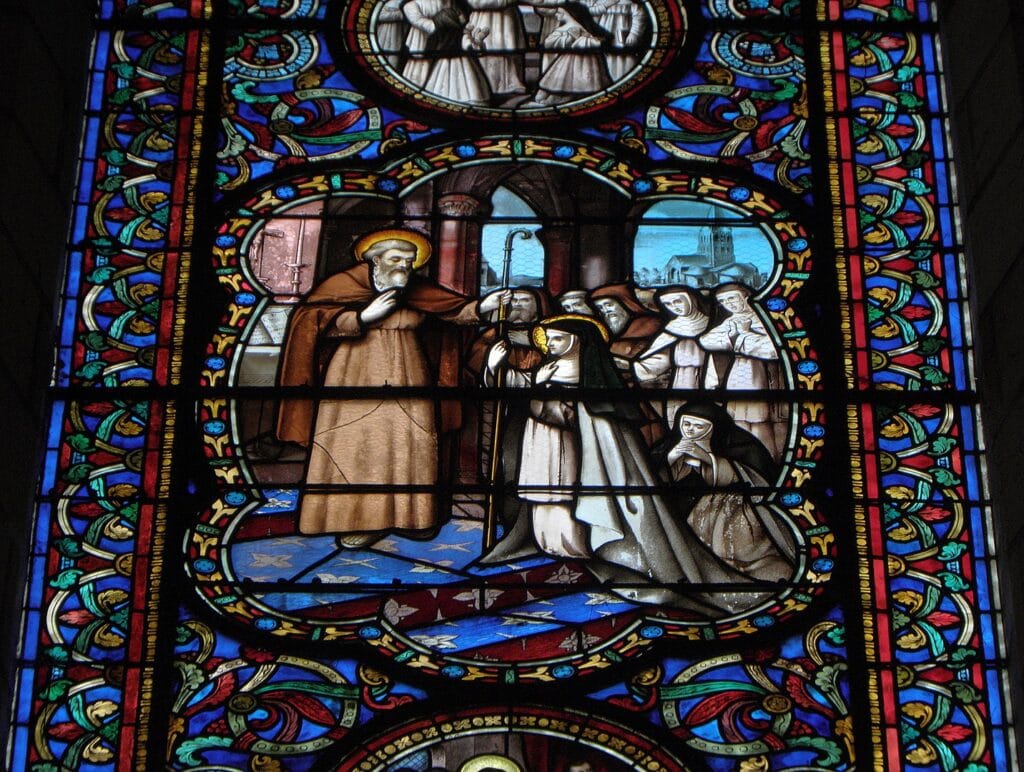
The Plantagenets were the Abbey’s greatest benefactors this was during the time when English Kings were actually French and owned vast territories in France from Aquitaine to Normandy.
Fontevraud Abbey Eleanor of Aquitaine
Fontevraud Abbey was a favoured establishment of the Plantagenet kings, including Henry II of England and his wife, the formidable Eleanor of Aquitaine, immortalised by Peter O’Toole and Katherine Hepburn in the epic 1968 film, The Lion in Winter.
Henry and Eleanor were great supporters of Fontevraud, and under their patronage, the foundation grew swiftly into one of the most important religious sites in the region.
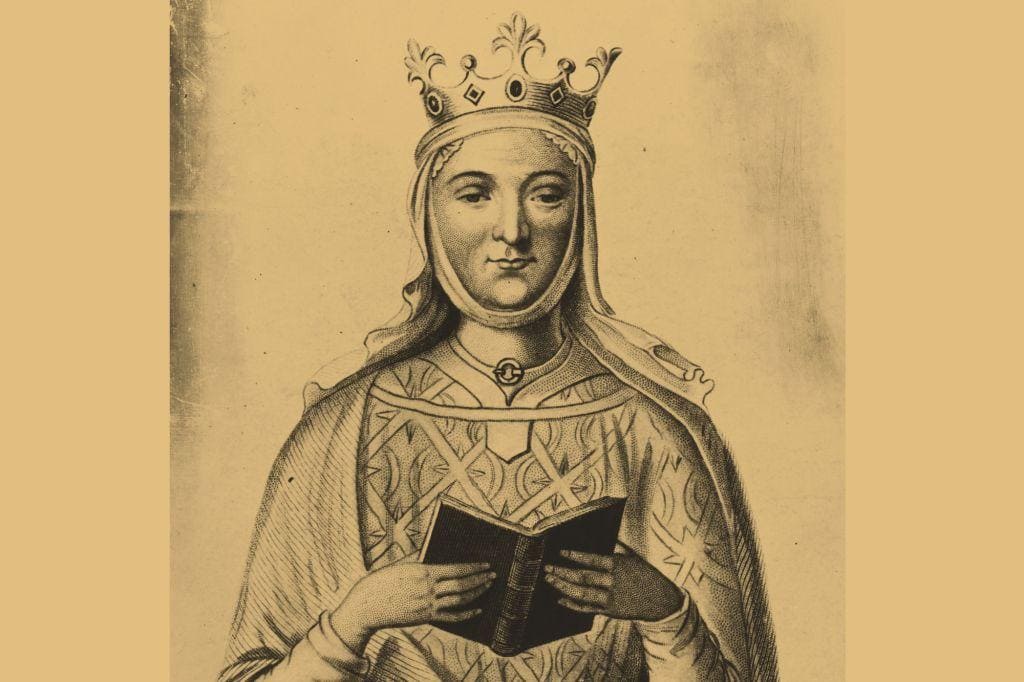
It was also distinctive in its organisation, divided into four priories that housed monks, nuns, lay brethren and lepers, all ruled over by a powerful abbess. The Abbey’s architecture was designed to host a mixed community, with the Great Monastery built for nuns, Sainte-Marie-Madeleine for women seeking to withdraw from the world, Saint-Lazare for the sick and Saint-Jean-de-l’Habit for monks.
What is the difference between a Monastery and an Abbey
Abbeys and monasteries are both religious establishments. A monastery is a cluster of buildings that house religious folk, either men or women, monks or nuns who have decided to remove themselves from the world to a life of contemplation and prayer. The abbey is a bigger community of either monks or nuns. If it houses monks, the abbey is usually led by an abbot or in the case of a women’s establishment then it is led by an abbess.
Eleanor of Aquitaine and Fontevraud
Eleanor of Aquitaine inherited the Duchy of Aquitaine, from her father in 1137. Three months later, she married King Louis VII of France. Shortly after the wedding the two went on the Second Crusade and headed for Constantinople where they stayed for three weeks.
They were joined by the surviving German forces on route and continued onto Ephesus before being attacked by a Turkish detachment. The French slaughtered the Turks and then decided to head towards Antioch.
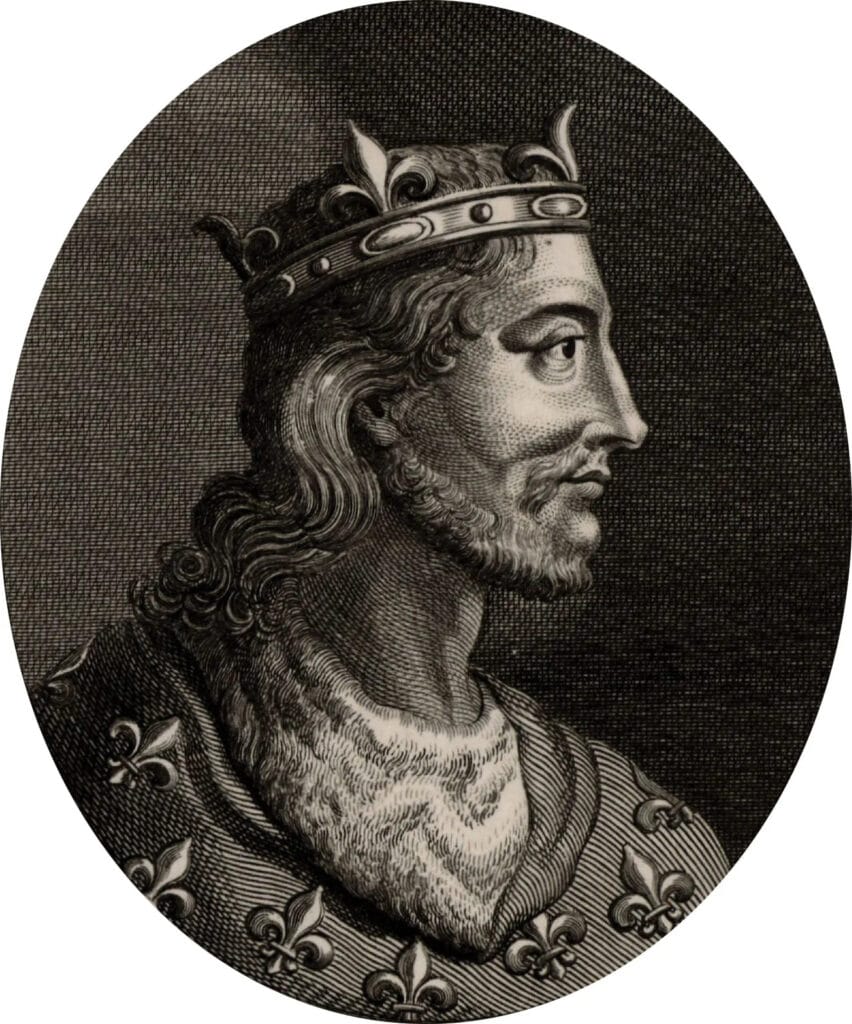
Eleanor led the groups across Mount Cadmus and Louis brought up the rear. The Turkish attacked the rear guard taking the French by surprise and killing many. Louis managed to escape but Eleanor was blamed for the attack. This resulted in the army splitting and the nobles retreating to the coast while the soldiers continued across Asia Minor.
Once they arrived in Antioch the arguments began. Louis wanted to make a pilgrimage to Jerusalem but Prince Raymon (Eleanor’s Uncle) wanted the troops to attack Aleppo.
By this time Eleanor was tired of being Louis’s wife and wanted to stay in Antioch but she began planning how to get out of the marriage. However, Louis forcibly dragged her onto Jerusalem where he arranged military support from King Baldwin III of Jerusalem and tried to attack Damascus. This violated the truce between Damascus and Jerusalem and failed.
As a result, Louis and Eleanor sailed for France in separate ships. The ships were attacked by the Byzantines and storms separated the ships so that Eleanor didn’t arrive in Sicily until two months later when she learned that she and Louis were thought to have been killed.
On their way back to France they stopped in Marseille to obtain a divorce based on the fact that they were cousins and should not have married. Pope Eugene III however proclaimed that the marriage was legal and prepared a special bed for them and instructed that they produce an heir. As it happened did actually happen but it was a girl, not the required male child. At this time they already had a child Marie born in 1145 and now Alice in 1150.
Louis was frustrated and he decided that an annulment was the answer so he convinced the Archbishops of Sens, Bordeaux, Rouens, and Reims and got the approval of the Pope.
Eight weeks later, in May 1152, Eleanor married again to Henry Count of Anjou who eventually became Henry II, King of England.
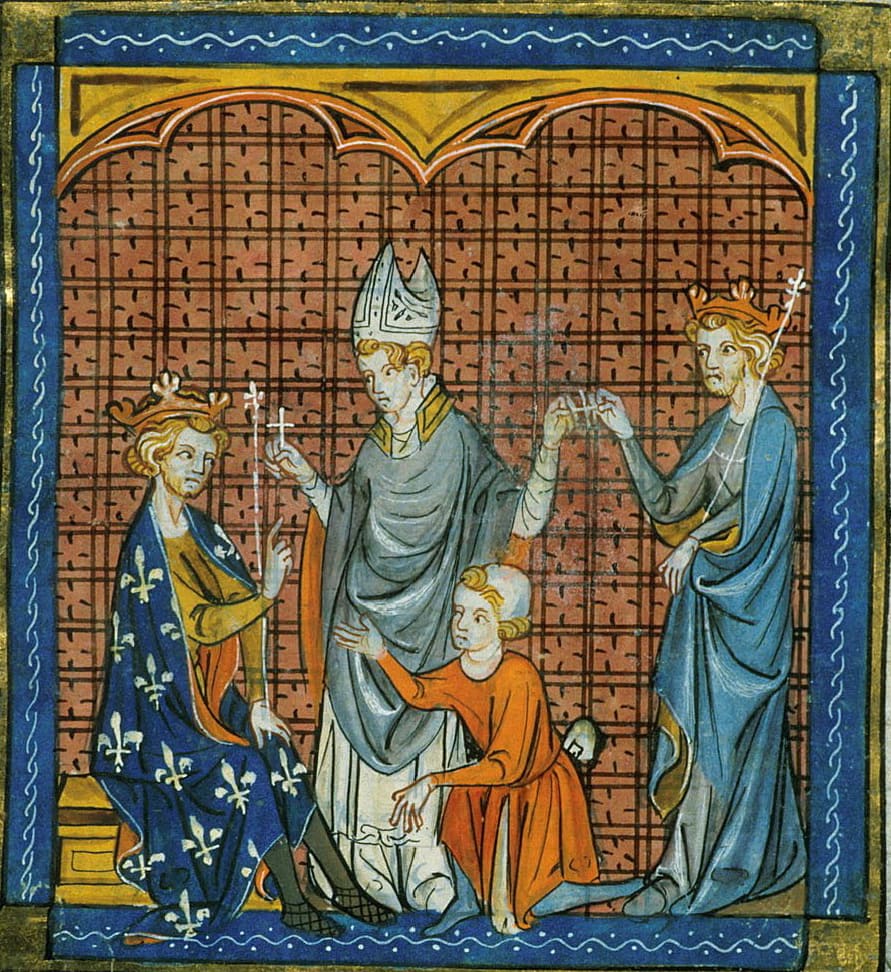
Anjou was a county centred around the city of Angers south of Normandy and lying between Paris and Brittany.
With Anjou and Aquitaine, the couple now controlled the southwestern quarter a third of what today is France. They controlled more of France than any ruler since the Carolingian Charlemagne.
The next year, in 1154, Henry, Count of Anjou and Eleanor of Aquitaine, also inherited control of the Duchy of Normandy and the throne of England. He became the English King Henry II.
Henry and Eleanor first visited Fontevraud in 1154. They put their two children Jeanne and John, the future king of England, in the care of the monastery.
Henry and Eleanor had 8 children together but he and Eleanor argued frequently. In 1173 two of Eleanor’s sons involved her in a plot against their father, and as a result, Henry imprisoned her in a series of castles including New Sarum in England.
Henry II died in Chinon in 1189, it is believed to have been caused by a bleeding ulcer. He had been fighting both his son and the King of France. Henry wanted to be buried in Grandmont on the Limousin but it was summer time and the Abbey Fontervaud was closer.
After Henry’s death in 1189, his eldest son, Richard the Lionheart (King Richard I) ordered his mother’s release. Despite her age, Eleanor became very closely involved in government. In 1190, she acted as regent in England when Richard went to join the Third Crusade. She even played her part in negotiations for his release after he was taken prisoner in Germany on his way home.
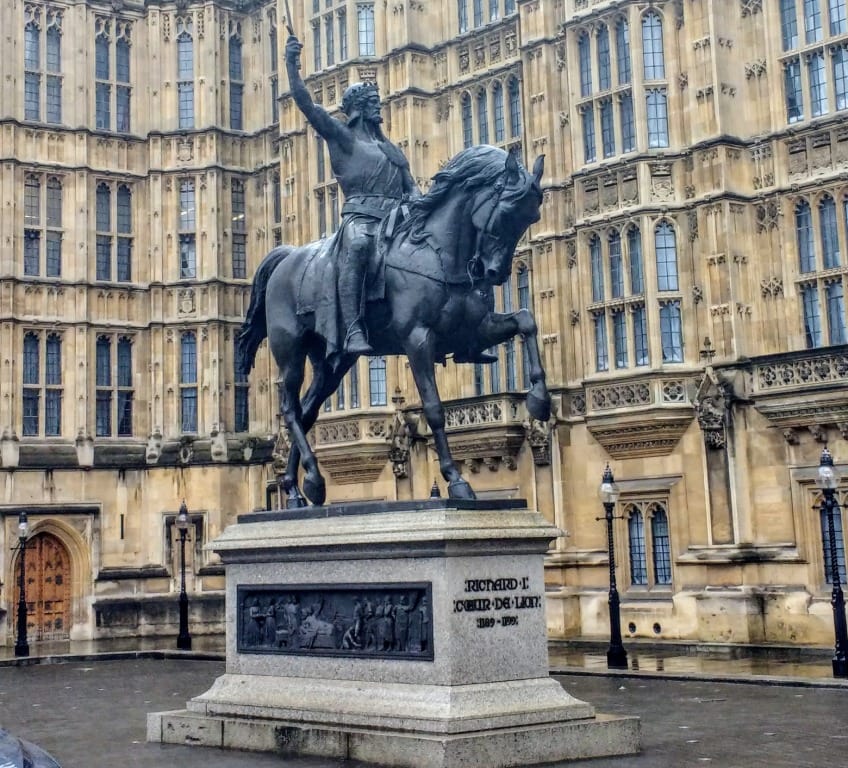
Burial place of Richard the Lionheart
In 1199, Richard Cœur de Lion or Richard Lionheart died and Eleanor brought his body back to Fontevraud for burial. His heart was buried in Rouen. Richard was succeeded by Eleanor and Henry’s youngest son, John. Eleanor’s role in English affairs now ceased, although she continued to be closely involved in those of Aquitaine, where she spent her final years. She died on 31 March 1204 and was buried in the abbey church at Fontevraud next to Henry II.
During the following, Hundred Years War Fontevraud lost much of its rents and lands. By 1534 Louise de Bourbon became the Abbess of Fontevraud. She was born at the Château de La Fère as the daughter of François I. de Bourbon, Count de Vendôme and Marguerite de Luxembourg-St-Pol. Louise de Bourbon left her crest on many of the alterations she made during her term of office, died and was buried there.
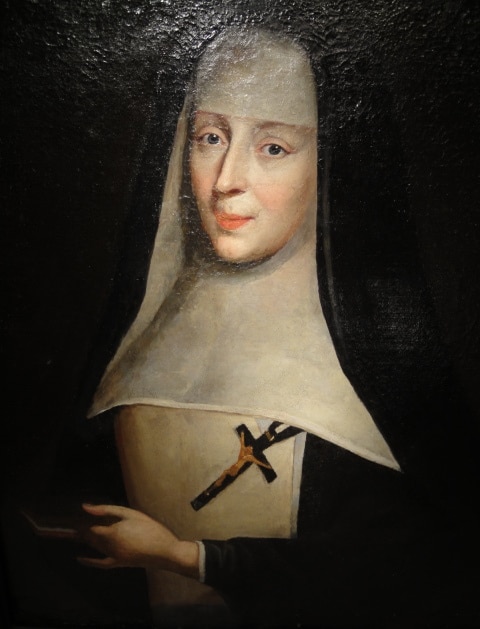
The French Revolution and Fontevraud
During the French Revolution, the order was dissolved. It is believed that during the Revolution the bones of the royals and nobles buried in Fontevraud were scattered and lost but the tombs remain. The last abbess, Madame d’Antin, died in poverty in Paris.
Fontevraud Prison
Fontevraud remained a functioning abbey until Napoleon sacked the buildings and converted it into a prison in the early 19th century.
In 1804 Napoleon signed a decree converting several former religious institutions including Fontevraud abbey and Mont Saint-Michel into prisons.
The first prisoners arrived at Fontevraud in 1812. Many changes had been made to the building including windows being blocked up and in the nave of the church, another two floors had been added. The prison was designed to hold 1,000 inmates, but by 1830 up to 2,000 were confined here.
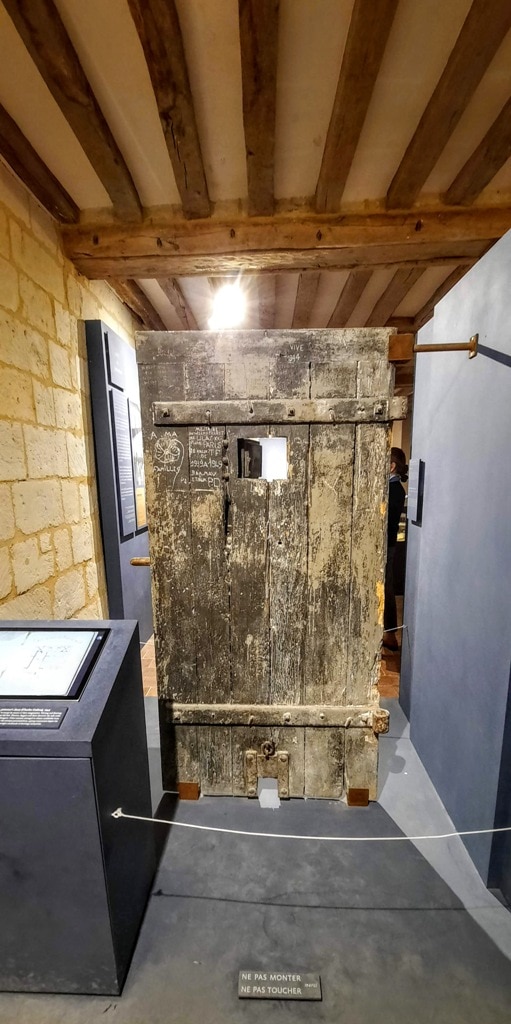
Most of the prisoners were transferred out in 1963 when Fontrvaud was handed over to the French Ministry of Culture. Over 40 of the most trusted prisoners were kept on to maintain the gardens and word on taking down the prison alterations to restore the Abbey.
What to see at Fontevraud L’Abbaye
The Abbey de Fontevraud is a magnificent example of Romanesque architecture. The stunningly bright and elegant interior of the Abbey Church has clearly been influenced by the women who ruled here.
There’s plenty to explore in the abbey complex, including the large chambers, dining halls, cloisters and gardens that were an essential part of the medieval foundation. If you stay at the Abbey Hotel you are allowed to wander this historic monument until 2 am.
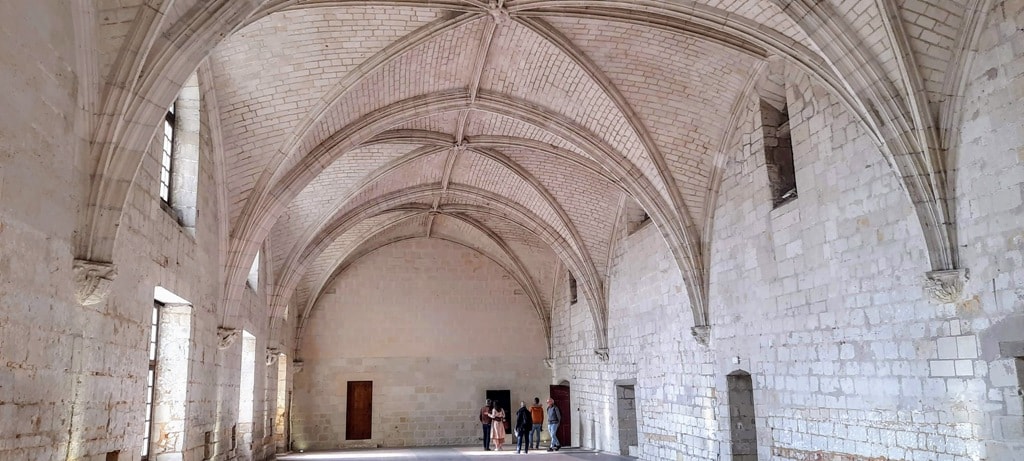
The Abbey is incredibly atmospheric and you need to take a few moments to simply sit and imagine a time when in this place historic figures walked, prayed and rested.
Fontevraud Abbey burials
The Abbey of Fontevraud became a royal necropolis upon the death of Henry II, King of England. Until the Revolution, the remains of the Plantagenets rested peacefully in the heart of the abbey church.
Although their remains are long gone the Abbey still contains the funeral statues of King Henry II, his son Richard the Lionheart and his daughter-in-law Isabella of Angouleme, as well as of Queen Eleanor commissioned the effigies or statues in polychrome tuffeau stone, which have been remarkably well-preserved.
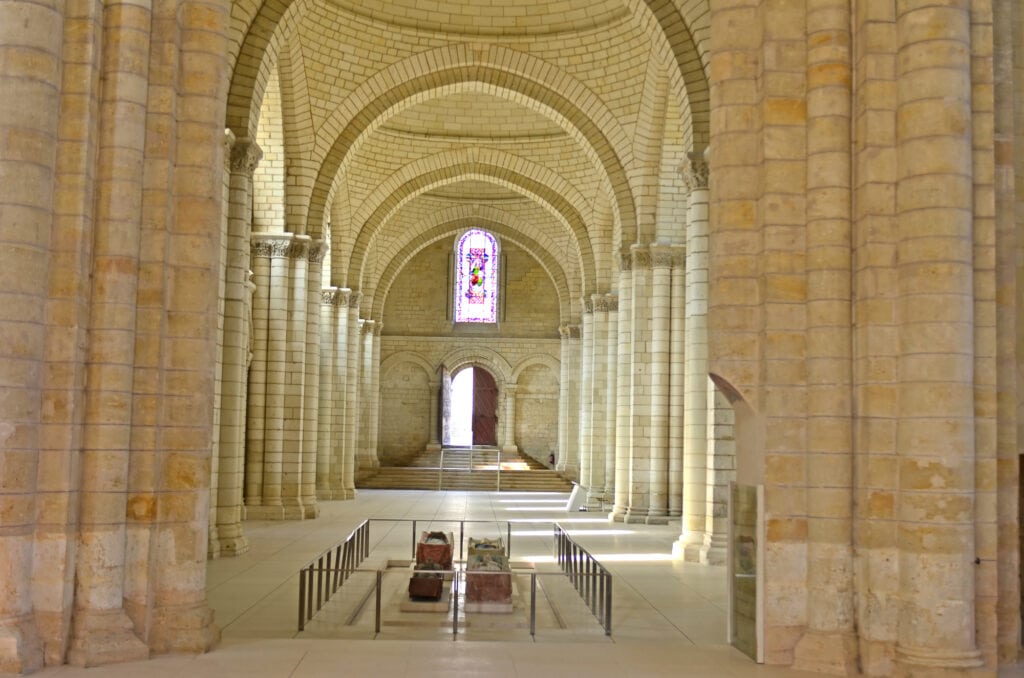
Henry II and Richard the Lionheart are represented with the royal sceptre and crown, while Eleanor is holding an open book. Eleanor commissioned the effigies and had hers stand higher than the man she married and grew to hate. The statue holds a book which Eleanor used to indicate her intelligence and her joy in learning and culture.
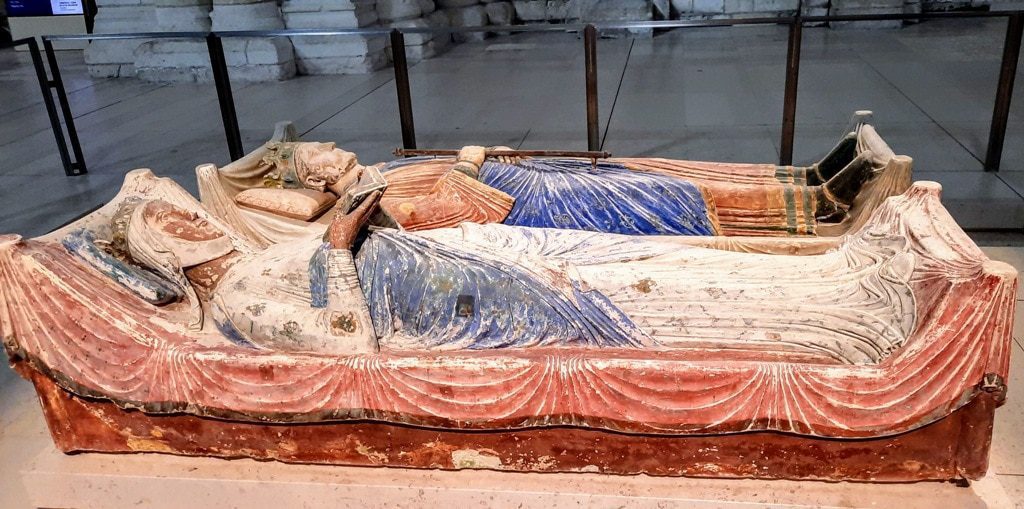
The effigies are located in the nave of the abbey church, whose roof is made of four vaulted spans reminiscent of the Norman style. The Church is the first building you can enter when passing through the visitors centre. The fourth tomb is that of Isabella of Angoulême (1186-1246), Queen of England the second wife of King John of England (1199-1216). The statue of Isabella is unique in that it is made of wood.
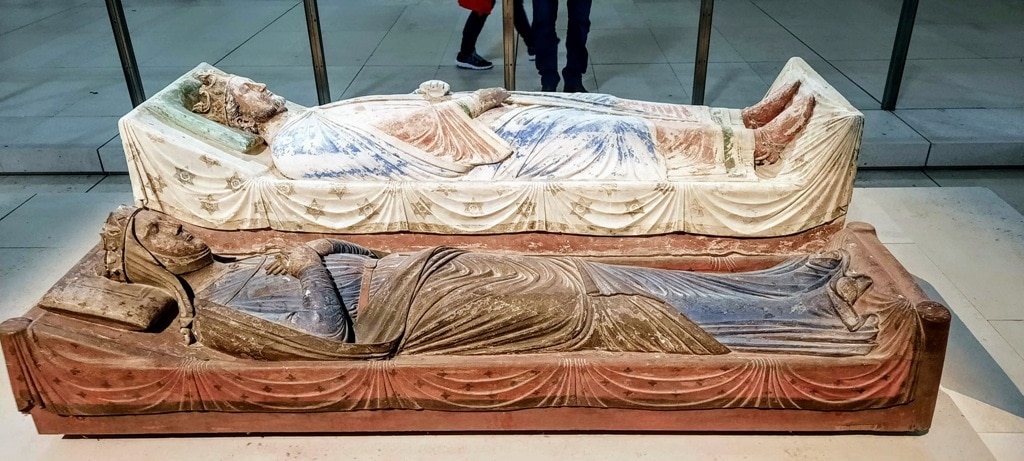
The choir and transept remain faithful to the local architectural style in the Loire Valley. This architectural amalgamation was later known as the “Plantagenet style”.
The church itself is magnificent there are the remains of paintings done in the middle ages. On the left-hand side, you can see a painting on the wall above the tomb of Raymond VII of Toulouse and it shows various coats of arms, golden griffons and crosses.
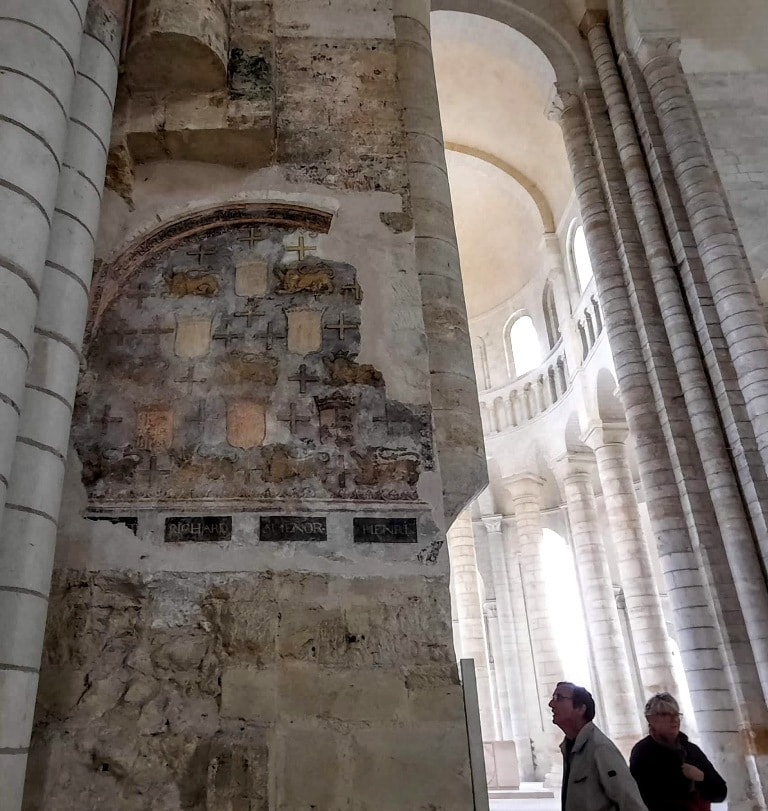
On the pillar side of that painting is another painting said to be that of Raymond VII Count of Toulouse 1197-1249. He was married to Joan the daughter of Eleanor and Henry.
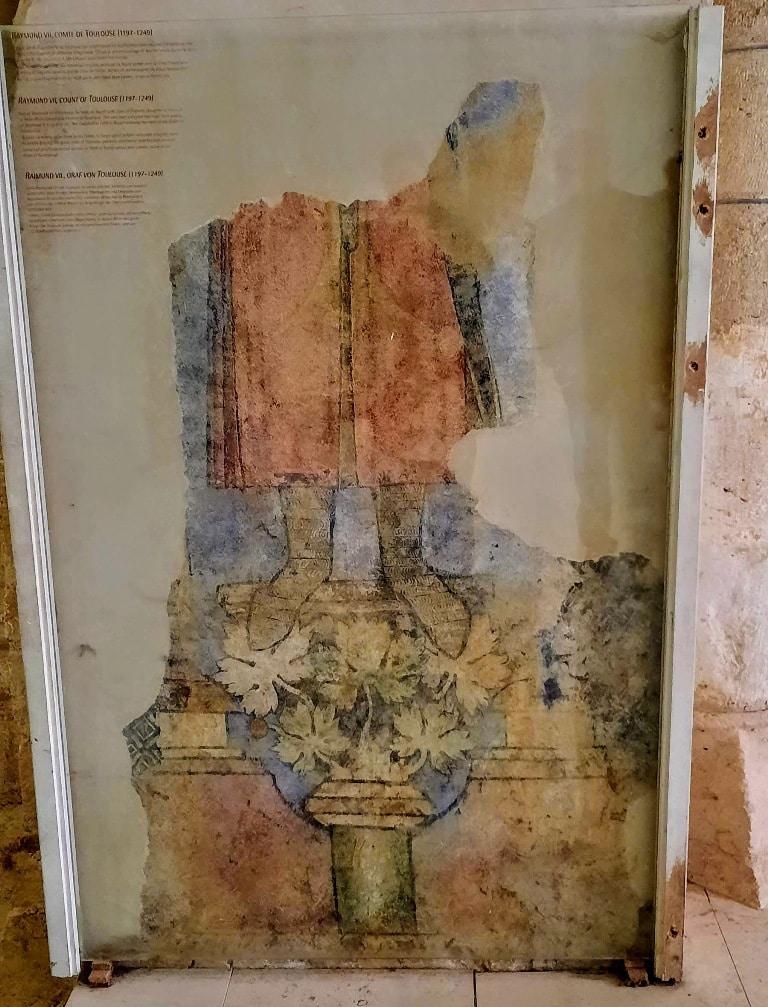
There is also a painting on the opposite side that seems to be that of Christ and the Romans. Obviously, the church at some point in time was decorated with painted statues and wall art that has now faded over the centuries.
The Romanesque Kitchen
Built in the 12th Century around 1140 the Abbaye Royale contains the Romanesque kitchen was classified as a Historical Monument. One of the most unusual kitchens in the world it is shaped as an octagon with 20 stone chimneys. The blacked stones show exactly where the ovens would have been. The roof is covered in tiles that appear to be fish scales and the gables of the roof all have small carved figures.
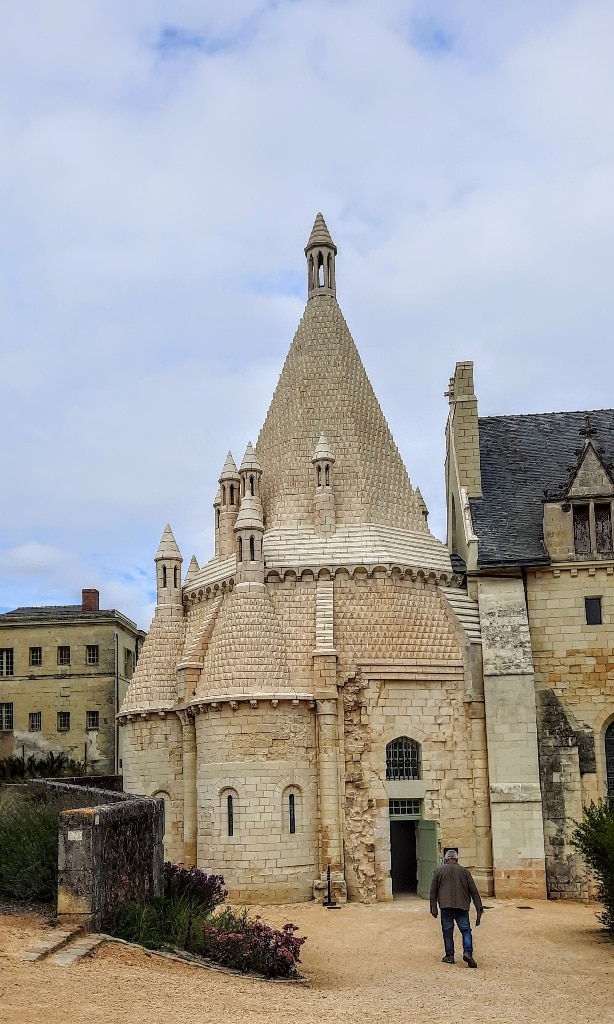
This fantastical kitchen which looks like something out of a dream may have actually been a 12th-century smokehouse that allowed fish from the Loire to be preserved but no one is truly certain.
The Cloister
The cloister represents the linking of heaven and earth and is at the heart of Fontevraud. It was rebuilt during the Renaissance and is one of the largest cloisters in Europe. The cloister is surrounded by dormitories, workrooms and prayer halls; the Salle Capitulaire (chapter room), with murals of the Passion of Christ by Thomas Pot; and a wonderful Gothic-vaulted refectory, where the nuns would eat in silence while being read the Scriptures.
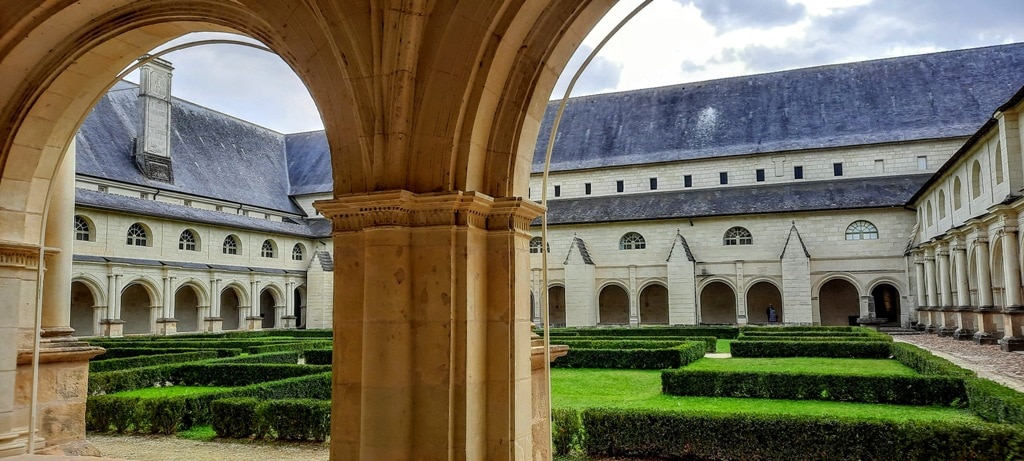
Chapter House
The chapter house is an incredibly imposing building with painted portraits of all the great abbesses of Fontevraud. The room opens into the cloister through two windows where you can see the dates of reconstruction in 1542 under Louise de Bourbon. The Chapter House is where all the business of the Abbey was conducted and managed.
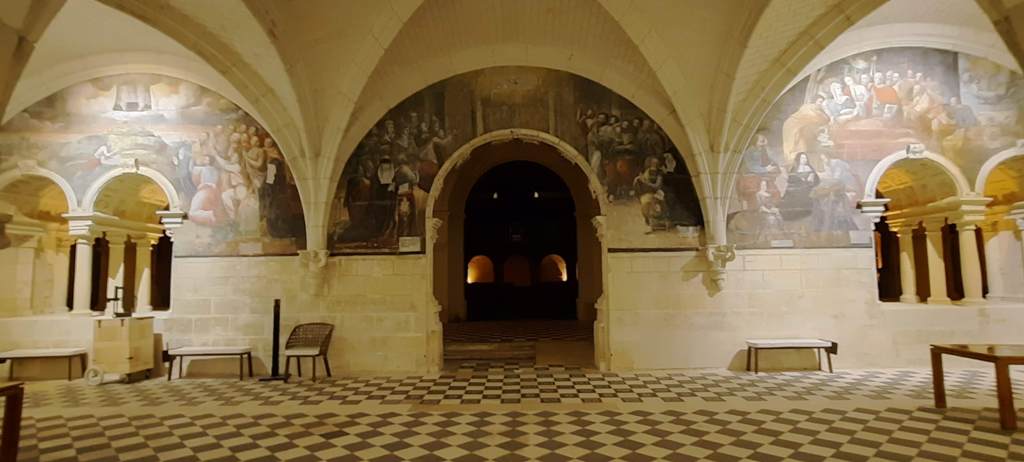
The portal and mullioned windows opening out onto the cloister are incredibly ornamental. There are plant motifs, and emblems (including the salamander which was associated with King Francis I of Chambord.
The frescoes decorating the lunettes in the vaulted chapter house date back to 1563 and were painted by Thomas Pot and depict the Passion of the Christ. In each fresco, you will see a kneeling Abbess which is believed to be the Abbess Louise de Bourbon (1673–1743), the daughter of Louis XIV, who began this ‘tradition’ these images were painted in much later than the original frescoes.
The Treasury Room
The former heating room of the royal abbey is located right next to the chapter house. Originally the only heated room in the Abbey, it was used by the nuns to carry out manual work such as writing or embroidery without their fingers going numb.
During the prison era, the boiler room was transformed into a kitchen. The boiler room is now known as the Treasury room.
Foundations And Crypt
In the church’s crypt, which opened in 2016, you can see the archaeological excavations of the earlier churches this excavation shows us the past of the Royal Abbey with, in particular, the discovery of the existence of a massive stone wall representing the Last Judgment, dating from before the death of Richard the Lionheart, in 1199.
The wall separated the nave into two sections, with the nuns on one side and the laypeople on the other. The face representing the Last Judgment, was carved in limestone and was only visible to lay people, and the wall was so high that nuns and lay people could not see each other.
The Crypt showcases 10 years of excavations and provides exceptional clues to the first years of construction of the Royal Abbey.
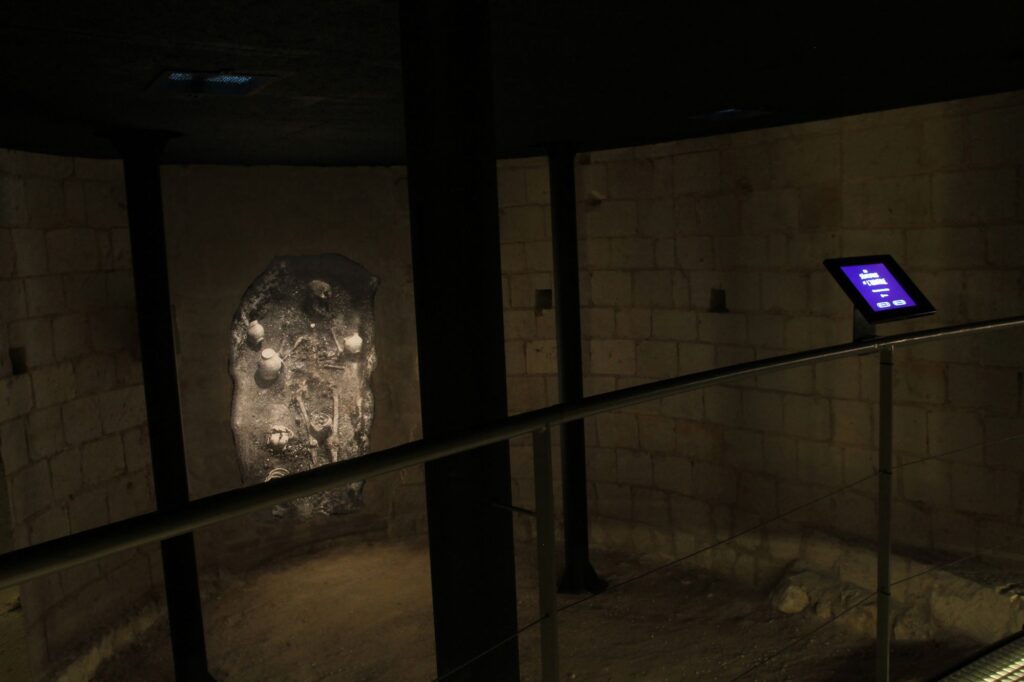
They discovered the grave of Robert d’Abrissel, the founder of the abbey in 1101, and the nuns’ catacomb. In total a hundred or so graves were discovered, nearly 900 years after the burials took place. Now the ‘crypt’ is presented to the public, who descend a steep narrow metal staircase to a metal walkway. Along the walkway are screens at points of interest with clever animated explanations of what you are seeing. These have been designed by the artist Eve de Roeck.
The Cellars
Used as a storehouse in medieval times the cellars extend under the visitor centre.
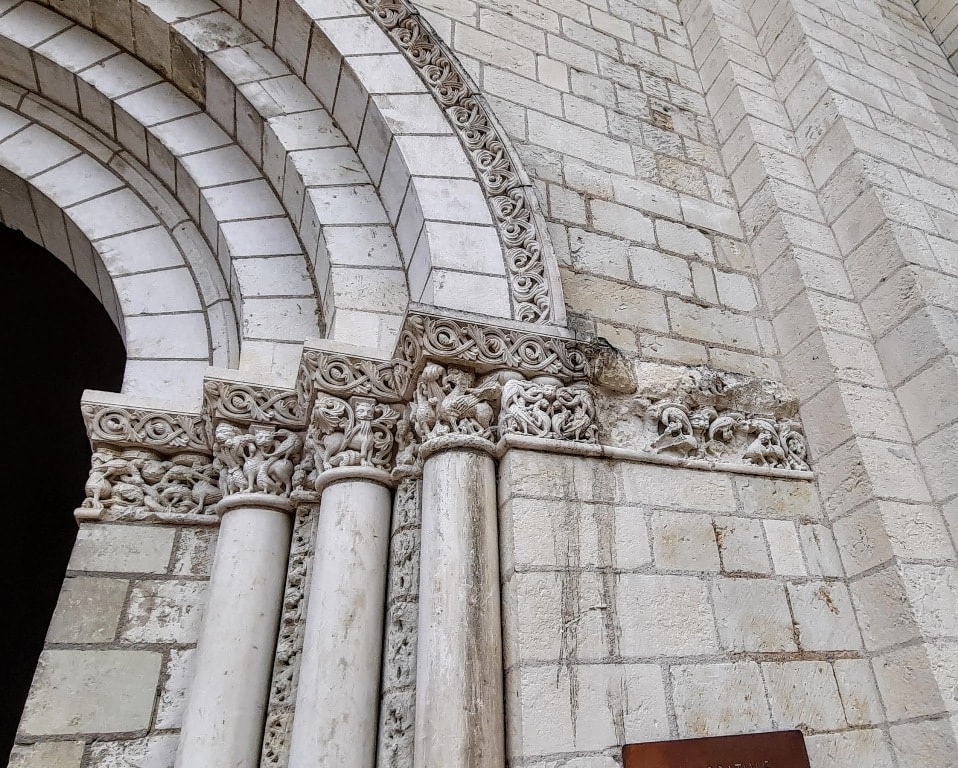
The Fontevraud Gardens
The Abbey Gardens were originally where all of the Abbey’s food was grown, it also included many medicinal herbs and an orchard. Today these organic gardens supplies produce for the Michelin-starred Fontevraud le Restaurant.
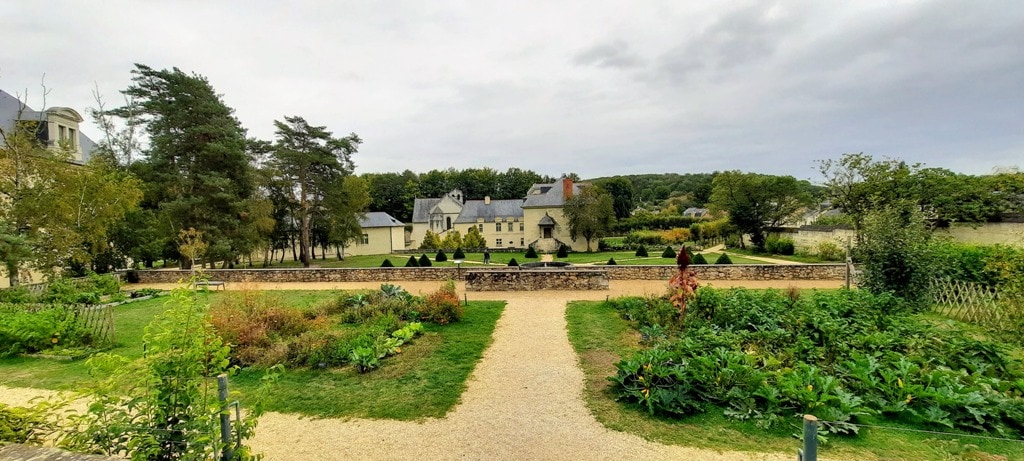
Overlooking the gardens is the Terrasse Gourmande where you can sit outside and observe the peace of the gardens over a cup of coffee or tea and a light lunch or snack.
Fontevraud Modern Art Museum – The Fannerie
Built in 1786, it is one of the most recent buildings at Fontevraud. By the end of the 18th century, it was home to the Mother Abbesses’ stables and then converted to a prison in the 19th century. The Fannerie gets its name from the hay that used to be stored there.
The Fannerie is now home to a Museum of Modern Art with donations from Martine and Léon Cligman’s personal collection. For more than sixty years, Martine and Léon Cligman collected paintings, drawings and sculptures by 19th and 20th-century artists, as well as antiques and artefacts from outside Europe (Africa, Oceania, Asia and the Americas). The Museum holds over 900 items donated by the couple.
The abbey regularly hosts contemporary art exhibitions and installations, concerts and plays. On 23 July 2018, the State received a donation of 561 works from Martine and Léon Cligman for the Pays de la Loire Region. A second donation of around 300 works to the Region followed in 2019. This collection constitutes the core of the Modern Art Museum at Fontevraud.
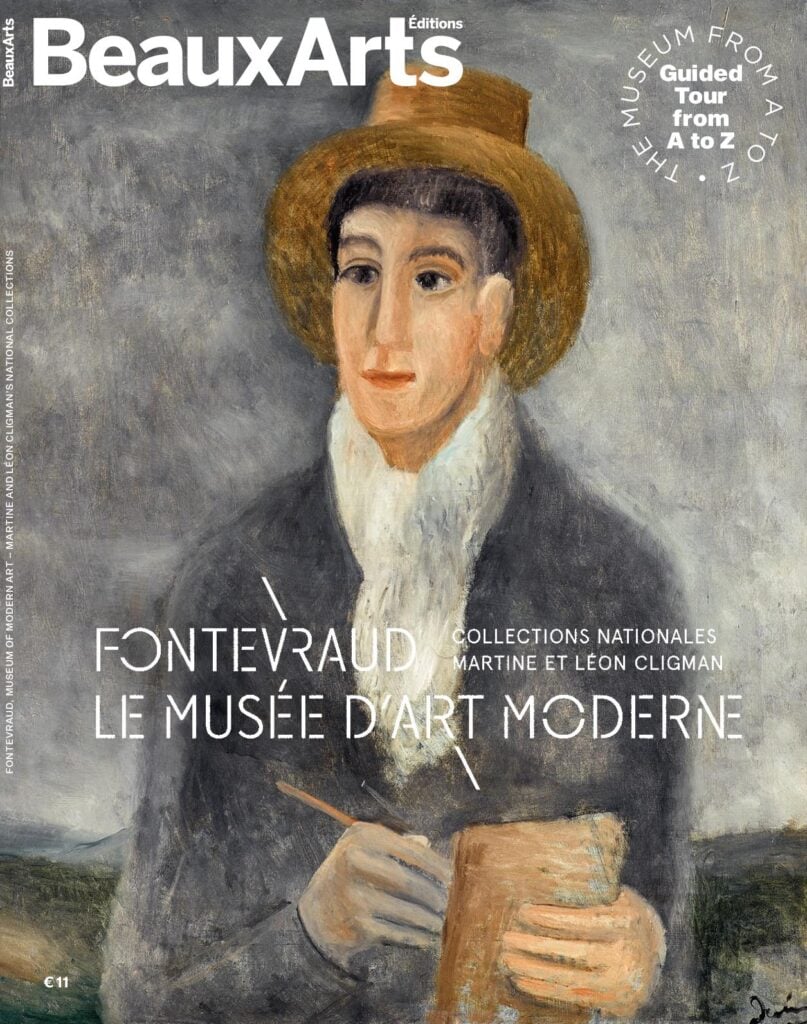
Fontevraud Visitors Centre
The visitors centre is complete with a gift shop, restaurants and interactive high-tech visitor experiences. The complex is open daily, year-round (except between Dec 25th and Jan 25th), and a family ticket may be purchased for €28. Audio guides, guided tours, and an interactive treasure hunt for children (complete with iPad) are available at an extra cost.
Ticket costs for Fontevraud Abbey
Fontevraud Abbey & grounds: Adult: 12 € – free for children and students under 25
The Modern Art Museum: Adult: 6 €
Fontevraud Abbey and the Modern Art Museum: Adult: 15 € – free for children and students under 25
Eglise Saint-Michel à Fontevraud-l’Abbaye
The Chapel of Saint Michel was built in about 1170 at the request of the abbess Audeburge of Fontevraud Abbey but it was too small to accommodate practitioners and was enlarged in the 15th century with donations from King Henri II Plantagenêt to become the parish church of the town.
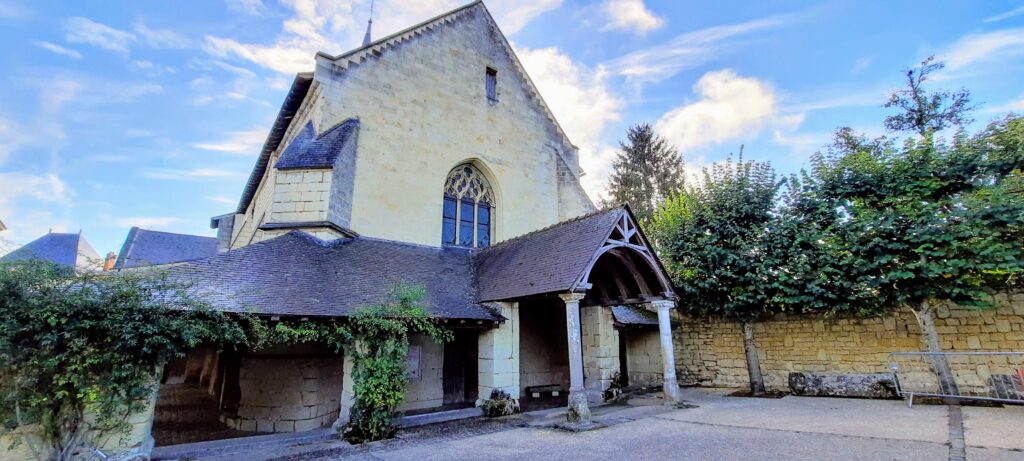
The church was modified again in the 17th century, when a chapel was added, dedicated to Saint Joseph, to the left of the choir, which still today houses a beautiful wooden cross from the 15th century.
The Romanesque church has a single nave with three bays, leading to the choir and the remains of stunning wall frescoes, beautiful stained glass windows, and columns with carved capitals and vaulted ceilings with carved faces.
Inside the church, you can admire the remarkably sculpted “Plantagenêt” vault to the right of the altar, as well as in the centre of the choir, the old altar of the abbey church and its beautiful fine gold gilding.
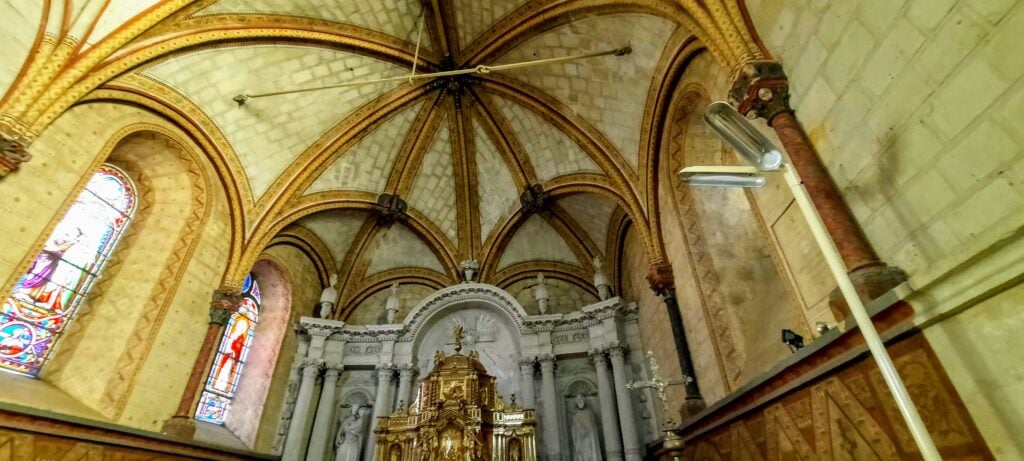
There are two painted heads carved into the vault of the choir which are said to be those of Henry and Eleanor.
There is a low ceiling wooden porch or walkway around the church which adds to its romantic appearance. The Saint Michel church has been listed as a Historic Monument since 1955, it is open every day with free access.
Where to Stay When Visiting the Abbey of Fontevraud
Fontevraud L’hôtel
If you want to immerse yourself in history you should stay at the Fontevraud Abbey hotel, situated in the beautifully restored rooms of the Saint-Lazare priory. Saint-Lazare Priory has been turned into a stylish high-end hotel and a restaurant allowing visitors to prolong the unique experience proffered by the Abbey. Imagine the life of the nuns in and around the cloister, sleep in buildings laden with history, dine in a Michelin-starred restaurant and enjoy the monasterial silence at nightfall.
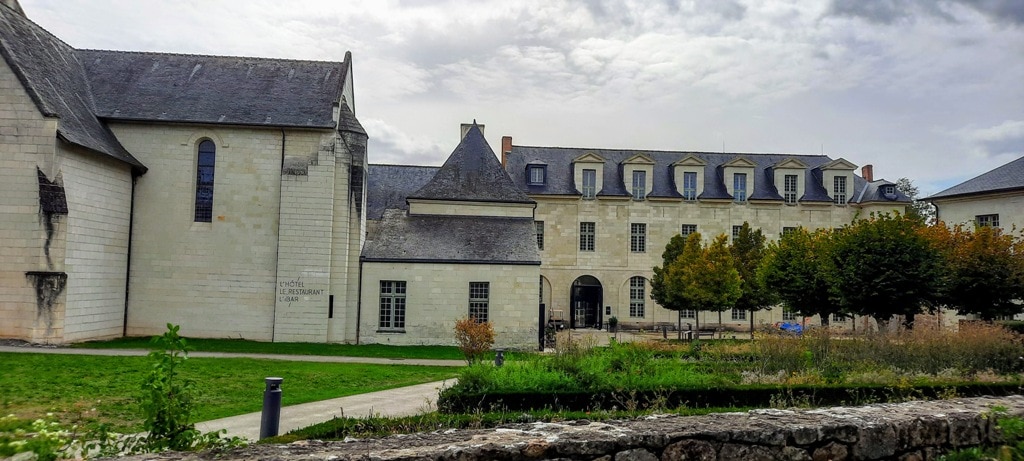
These simple, elegant rooms are converted nuns’ cells and are simply decorated and comfortable. The accompanying restaurant, run by award-winning chef Thibaut Ruggeri, is the perfect way to round off the experience.
A word of warning don’t eat the room service food or the breakfast buffet they are both very overpriced and the food and coffee is terrible.
Logis Hotel La Croix Blanche Fontevraud
Our friends highly recommended the Hostellerie La Croix Blanche which is located opposite the Fontevraud Abbey. It features a modern French restaurant, a lounge bar, a flowered terrace and a seasonal heated outdoor swimming pool. Free high-speed WiFi is available.
This former coaching inn dates back to 1696 and offers rooms with contemporary décor and furniture, a desk and a flat-screen TV. Free entrance tickets to local wineries, maps and tourist information are available from reception or the local tourist information centre.
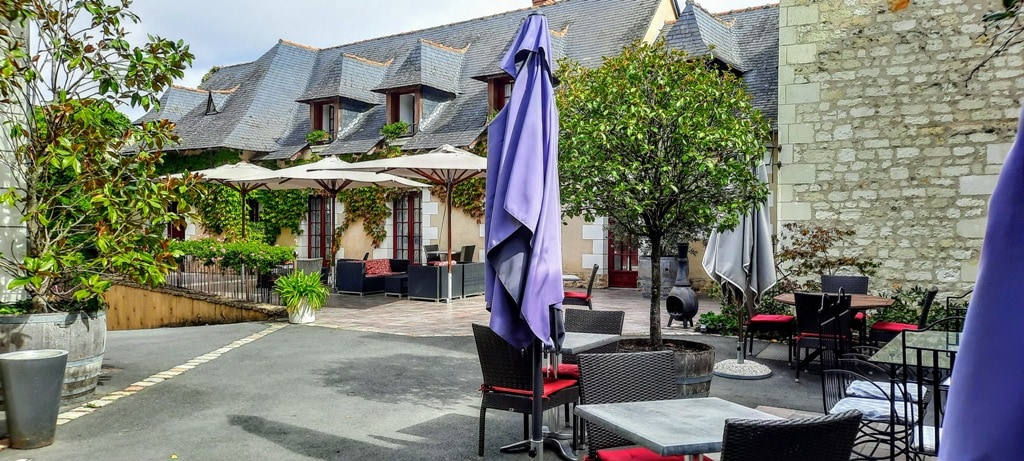
A buffet breakfast is served each morning and can be enjoyed on the terrace. The bistro restaurant offers modern French cuisine and an extensive regional wine list. Lunch and dinner are also served in the historic 17th-century courtyard, or the town square facing the fountain and abbey. In winter meals are served in front of the fireplace.
Chez Mimie les Hotes
Situated a few feet from the Fontrevaud Abbey Chez Mimie les Hôtes offers accommodation with a patio, as well as a restaurant and a bar. There is a buffet breakfast available and a terrace for dining. This is a quirky little hotel with very reasonable prices and is very conveniently located.
Where to eat at Fontevraud
We ate at the La Croix Blanche Restaurant on our second night in Fontevraud and were blown away by the food it was incredibly good.
I had the Anjou Menu – which was 35€ and included; La Gouline a local puff pastry pie with Rillauds which are pieces of pork belly made up of both the fat and the meat that is left to rest in a salt and herbs brine. The pork belly is then defatted and the same fat is used to cook the meat in the lard.
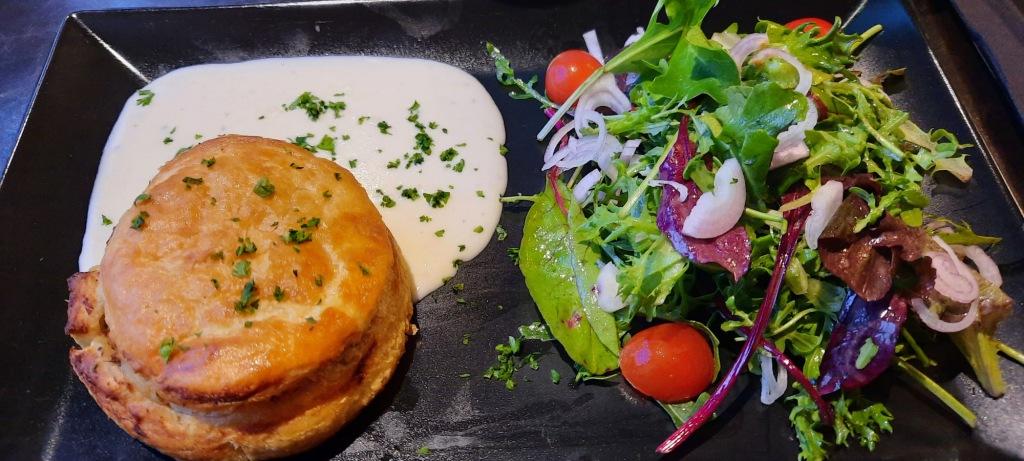
This was mixed with local mushrooms, and shallots and served in a Tomme cream sauce.
The mains was a supreme of chicken with creamy gravy with mushrooms and wine along with a celeriac mousse.
The dessert was a traditional Crémet d’Anjou which is fresh cream with whipped egg whites and a stunning fruit compote topped with tiny crunchy pieces of ginger biscuit.

Hubs had a glorious ceviche and then a steak and frite mains with herbed butter and for dessert his favourite sorbets of vanilla, café and pistachio which he enjoyed immensely.
I would honestly say this was one of our top 5 meals in France absolutely superb.
The Abbey Fontevraud stands as a remarkable testament to centuries of history and architectural ingenuity. Its grandeur and distinctive features captivate visitors from around the world. The abbey’s unique blend of Romanesque and Gothic styles, along with its significant role as a burial site for royalty, adds to its allure.
The meticulous preservation and restoration efforts have ensured that this magnificent site continues to inspire and educate future generations about the rich cultural heritage of the region. As visitors explore the abbey’s majestic buildings and stroll through its peaceful grounds, they are transported back in time, immersing themselves in a world that once thrived within these ancient walls. Fontevraud Abbey remains a true treasure, inviting all who encounter it to appreciate the beauty and historical significance it embodies.
Have you been to Fontevraud Abbey? I would love to hear your thoughts.
You might also like to read
French Food Culture: The Ultimate Guide
14 Fabulous French Castles to visit
Visiting Fougères France – City of Art and History
Granville France –childhood home of Christian Dior
Food in Brittany: Fall in love with the food of Bretagne
Pin it to save it
